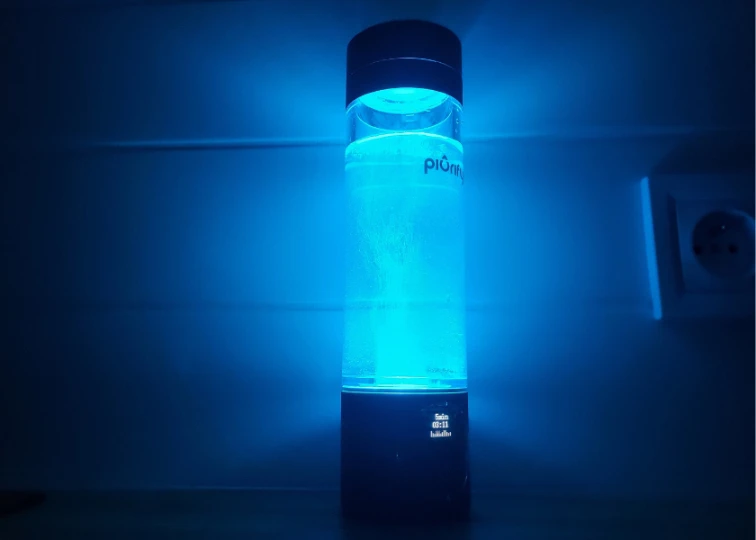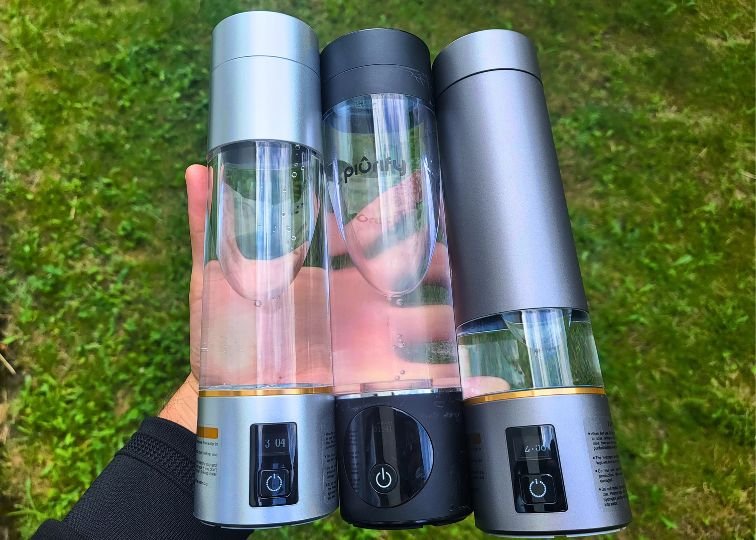You’ve probably heard of water bottle materials like stainless steel, plastic, or even glass. But there’s one material that stands out as a little more unusual – copper. Yes, copper water bottles are a real thing, and they’re becoming increasingly popular.
Naturally, I had to see what it was all about. So, I ordered a few copper bottles online and used them interchangeably for two months. Out of all of them, the one that impressed me most was the Artisan’s Anvil bottle. In fact, I’d go as far as calling it the best copper water bottle I’ve tried, and that’s the one I’ll be reviewing here.
This bottle is a statement piece. With its regal, handcrafted look, it feels both exotic and elegant. And beyond its design, it comes with some surprising health benefits that I’ll discuss later in this article.
Some of the links on this page are affiliate links. This means that if you click on one of the links and make a purchase, I may earn a small commission at no additional cost to you.
Overview
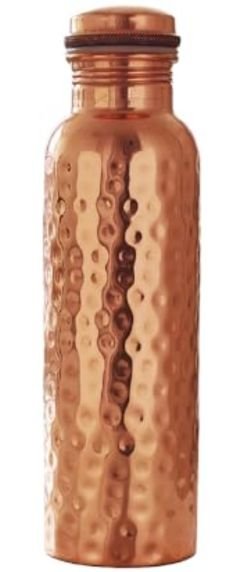
KEY FEATURES
PROS
CONS
Insulation
When it comes to insulation, copper water bottles have a clear limitation: they generally don’t keep drinks hot or cold for long. That’s because most copper bottles, including the ones I’ve tried, are single-walled.
With just a thin layer of copper, heat transfers quickly. Hot water makes the exterior of the bottle uncomfortably hot to touch and ice cubes tend to melt quickly.
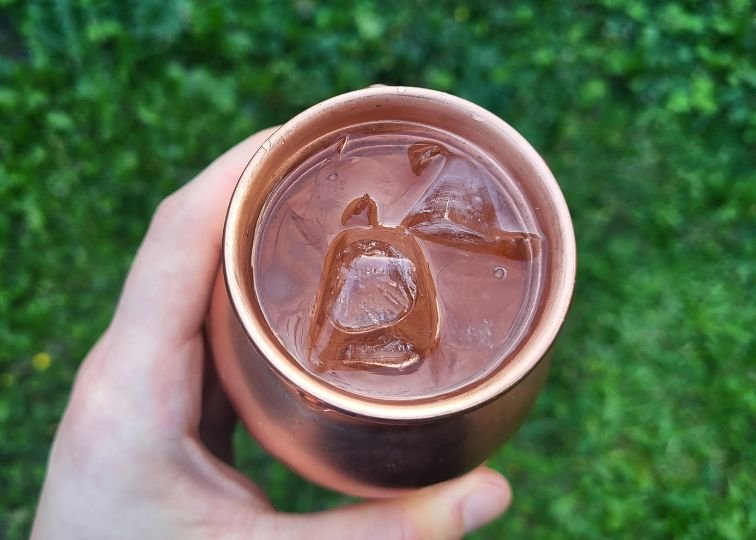
If you’re looking for real temperature retention, you need a double-wall vacuum design. In this regard, copper bottles will always fall short compared to best stainless steel bottles.
Smell & Taste
One thing to be aware of is that copper bottles have a characteristic metallic smell. The first time I noticed it, it immediately reminded me of 5-cent coins, which are 75% copper, so the resemblance makes sense. Even if you touch the bottle and then smell your hand, there’s a faint “nickel-like” scent for a short while. It didn’t bother me much, but it’s something to keep in mind.
As for the taste, I didn’t notice any significant difference compared to bottles made from other materials, which is definitely a good thing.
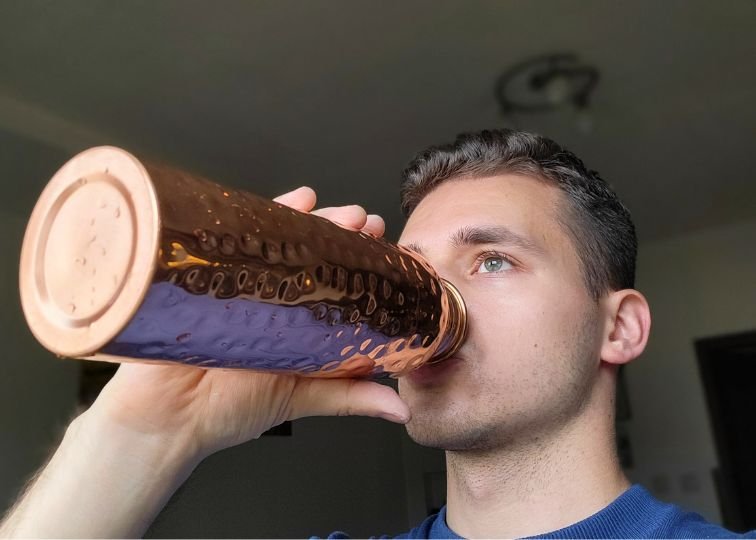
Durability
Since this bottle is single-walled, it’s naturally less durable than the sturdier double-walled stainless steel bottles. I wouldn’t call it “fragile” like glass, but it’s definitely not as tough as stainless steel.
Unlike most stainless steel bottles with rounded bottoms, this one has a flat base, which could make it more prone to dents. Scratches are also fairly easy to get, so overall, you’ll need to handle this bottle with a bit more care.
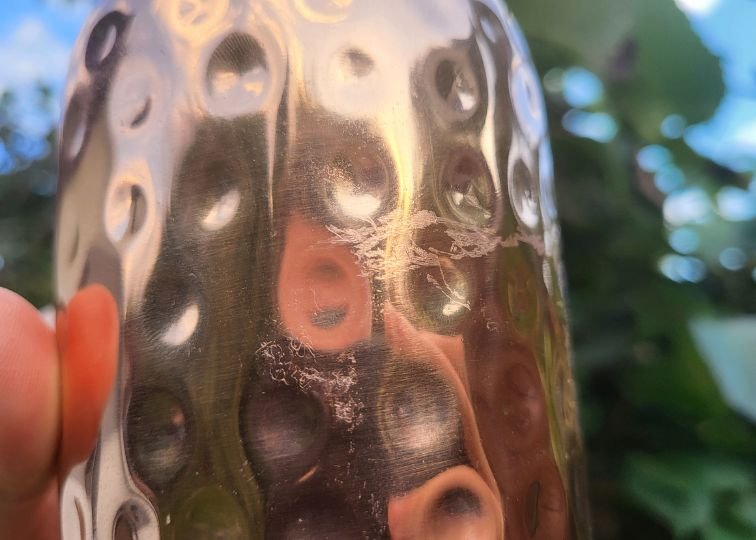
Leakproofness
This bottle has been completely leakproof for me – no exceptions. It doesn’t rely on any fancy mechanisms or complex engineering; it’s just a simple copper cap with a silicone gasket that screws on and off. And surprisingly, that’s all it takes to keep it from leaking.
What I particularly like about the cap is that it’s made entirely of copper (aside from the silicone gasket). That means your water is always in contact with copper – no plastic anywhere in sight. It’s hard to put into words how rarely I come across bottles that are completely free of plastic these days.

Portability
The first thing I noticed about this bottle is how exceptionally light it is. It’s a pleasant surprise, since the weight of my bottles is important to me. I don’t own many items made entirely of copper (probably none, actually), so I expected a bottle made from this material to weigh at least 20 ounces when empty. I was wrong.
In terms of weight, this bottle is highly portable.

That said, it doesn’t have any handles or loops, so you need to hold it all the time when carrying it. That can be a bit annoying, but most copper bottles follow this same minimalist design.
Thankfully, the hammered pattern on the bottle’s body isn’t just for looks – it provides extra grip, which makes holding it more comfortable.
There’s another feature that boosts portability: the included carrying bag. Made of canvas, it matches the bottle’s aesthetic perfectly and is a surprisingly nice bonus.

Ease of Cleaning
First things first: copper bottles and dishwashers do not get along. But don’t worry, handwashing this bottle is surprisingly easy. Thanks to its wide mouth, even a lazy scrub is enough to get it sparkling.
Since we use copper bottles for water, there aren’t any stubborn spots or weird residue to worry about. The only minor hiccup? At 10.75 inches tall, you’ll need a long brush (with soft bristles) to reach the bottom – but hey, think of it as an excuse to upgrade your cleaning tools.
For more advice, check out my guide on how to clean a copper water bottle.
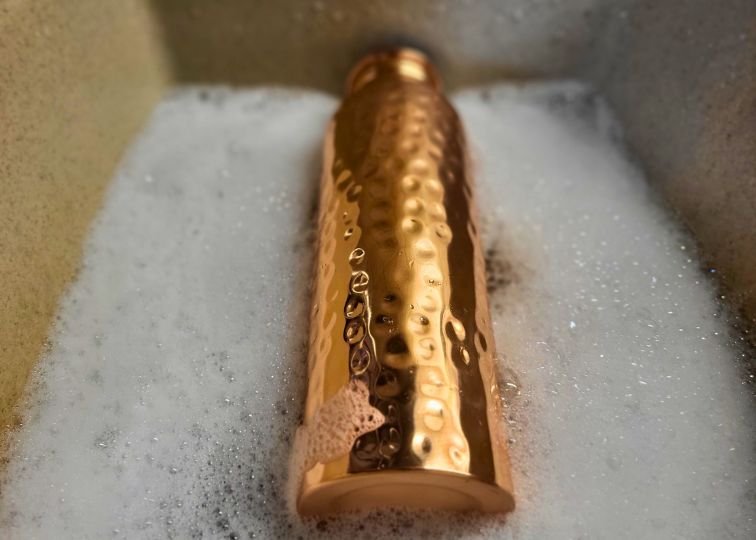
Versatility
In simple terms, this copper bottle isn’t the most versatile. I don’t take it out of the house much. Its lack of insulation and moderate durability make it better suited for home use. That’s exactly where I use it.
But here’s the fun part: it’s a fantastic conversation starter. Guests often notice this shiny vessel on my table and frequently mistake it for a vase. That’s my cue to talk about Ayurveda and the potential health benefits of copper water. Suddenly, a simple bottle becomes a topic of discussion. I love having interesting items like this that naturally spark conversations, and this bottle definitely delivers on that front.

Price/Value Ratio
I paid $35 for my Artisan’s Anvil bottle on Amazon, and as usual, there are often discounts and coupons, so that’s where I’d recommend buying it.
I was pleasantly surprised by the price – I had assumed copper bottles would be much more expensive, especially as their popularity keeps growing. In fact, I’ve seen some copper bottles priced as high as $300! Compared to that, this one is a real bargain.
For that price, you get a bottle that offers science-backed health benefits. And that brings us to the big question, which is…
Is It Worth Buying a Copper Water Bottle?
If we strip a copper bottle down to its essence, it’s… well, just a fancy, shiny water container. Alone, it doesn’t do much that your average bottle doesn’t. The magic, or at least the reason people pay attention, lies in the potential health perks.
The idea is simple: water stored in copper can absorb trace amounts of copper ions. Tradition swears by it, and a few scientific studies nod in agreement.
From there, two main benefits emerge:
- Increasing copper intake
- Killing bacteria
Copper is an essential trace mineral, involved in everything from energy production to brain function. So, theoretically, sipping water from a copper bottle adds a pinch to your daily intake. Sounds perfect, right? A little sip here, a little boost there.
But copper deficiency is rare. Most people get plenty from everyday foods, and the average diet (especially in the U.S.) already meets or exceeds the recommended daily allowance of 0.9 mg (though it’s difficult to consume too much copper).
So while copper water can technically contribute to your intake, it’s not exactly a “game-changer” for most of us.
The second benefit, however, is far more interesting. Copper has real antimicrobial properties. Contaminated water can carry harmful bacteria like E. coli, Salmonella, and even Vibrio cholerae. I usually use filters anyway, but no filter can guarantee 100% removal – there’s always a tiny chance some bacteria slip through, either due to pore size limitations, imperfect flow, or filter wear.
Remarkably, simply storing water in a copper vessel may neutralize these nasties. This is exactly why I bought my copper bottle.
If this sounds appealing to you too, a copper water bottle isn’t just a shiny object, but rather a small investment in cleaner, safer water. And with science backing up this particular benefit, I’d argue that in this respect, it’s genuinely worth the money.
Artisan’s Anvil Copper Water Bottle |
|---|
 |
Final Score: 4.4/5 |
Sources
https://www.healthline.com/nutrition/copper-water-benefits
https://pmc.ncbi.nlm.nih.gov/articles/PMC3067274

Jeremiah Kowalski
Hey there! I’m Jeremiah, the guy behind WaterBottleAdvisor.com. I used to have a bad habit of guzzling sodas while working remotely, but thanks to reusable water bottles, I’ve turned my hydration game around. After testing over 50 bottles, I’m here to help you find the perfect one to make staying hydrated a joy, not a chore. When I’m not reviewing bottles, you’ll likely find me scaling steep trails around the world, trusty water bottle in hand.


